FoalWatch
This treatment applies to the following species:Test Kit for Daytime Foaling Management
Safety Informaton
Read SDS (available at www.foalingwatch.com) before performing this test procedure. Wear safety glasses and protective gloves.
General Introduction
Normal pregnancy length can vary widely in the mare. Thus many nights can be spent waiting up for the mare to foal. Physical signs of the mare’s approaching readiness for foaling include an appropriate gestation length of greater than 320 days, udder enlargement with the presence of colostrum (milk) in the teats, waxing on teat ends and relaxation around the tail head, buttocks and lips of the vulva. While helpful, none of these signs are extremely accurate as a means of predicting when the mare will foal. Recent studies of pre-foaling milk (mammary secretion) electrolyte changes have demonstrated an increased ability to predict foaling time. These electrolyte changes (especially with regard to calcium level) have also been shown to be related to the development of maturity of the foal in the uterus and its subsequent survivability (viability) following a normal delivery.
This kit has been developed from years of extensive research and testing. The intent is to assist you in determining when the mare is likely to foal based upon changes in the pre-foaling milk calcium level. It is a tool that can allow you to attend your mare’s foaling without an excessive number of sleepless nights.
The advantages of this kit include its accuracy and repeatability compared with other test kits on the market, its ease of use, its quantitative determination of the calcium carbonate level in each sample tested and its economy.
When To Begin Testing Your Mare
Begin sampling and testing approximately 10 to 14 days in advance of your mare’s expected foaling date (calculated as 335 to 340 days from her last known breeding date). In mares with an unknown breeding date, testing should begin as soon as you note some udder enlargement, and secretions can be obtained from the teats without undue effort. It is best to keep a close check on udder development on a daily basis and practice massage of the mare’s udder and teats to allow her to get used to your presence in this area. Once a day sampling is sufficient until you begin to get test results that exceed 100 ppm. Then twice daily sampling is recommended. The more accurate assessment of your mare’s readiness to foal will be a late afternoon or an evening sampling each day (as most mares foal at night). Since a few mares do foal in the daytime, a morning sampling should not be neglected and is highly advisable when test results first exceed 125 ppm.
Sample Collection
Some mares are resentful of being milked, especially if they are maiden (first-time foaling) mares. Standing to the left side of the mare and facing her tail, press your shoulder firmly against her chest, reach with your right hand first to her belly near the umbilicus and rub gently and progressively toward the udder. Several attempts may need to be made to reassure the mare that you mean no harm. Try to make this a pleasurable experience for the mare by offering her some grain while collecting the sample. The more comfortable she is with you collecting her milk, the easier it will be for her to accept her new foal attempting the same procedure.
It is not unusual for maiden mares to fail to develop much of an udder prior to foaling, in which case, your ability to obtain a sample for testing will be greatly hampered. The ‘first milk’ (colostrum) is typically a very thick, honey-colored, sticky secretion. This is an appropriate sample to recover as calcium levels will be detectable just as with more ‘normal’ appearing milk.
Since calcium contributes to the hardness of water, all precaution should be used to rinse all re-usable items exceptionally well with distilled water prior to drying. Use only distilled water (supplied or purchased) for all sample dilutions in the testing procedure.
TESTING PROCEDURE
1. Wipe the udder and teats with a clean, dry, soft paper towel.
Note: This will reduce contamination in the sample and is most critical if the mare has been out in the weather and is wet. Your hands should also be clean and dry.
2. Obtain a 2 to 5 mL sample of mammary secretion by gently stripping a small amount from each teat (using thumb and index or middle finger) into the small plastic beaker.
Note: You may transport the collected sample to a clean, dry, warm area to perform the remainder of the test procedure.
3. Using the 3 mL syringe, draw up exactly 1.5 mL (cc) of the mammary secretion sample.
Note: Be sure that you do not have any air bubbles in the syringe barrel.
4. Dispense the 1.5 mL sample into the 25 mL sample cup.
5. Using the 10 mL syringe, draw up exactly 9 mL (cc) of distilled water.
Note: Be sure that you do not have any air bubbles in the syringe barrel.
6. Dispense the 9 mL of distilled water into the 25 mL sample cup.
7. Cap the sample cup. Mix the contents gently.
8. Add 1 drop of A-1700 Indicator Solution and once again mix the contents of the cup gently.
9. Push the valve assembly onto the Titret ampoule tip until it fits snugly (fig 1).
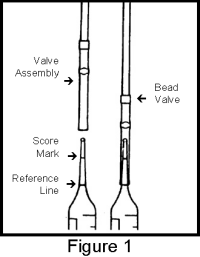
Note: The valve assembly should reach the reference line on the neck of the ampoule.
10. Snap the tip of the ampoule at the black snap ring (fig 2).
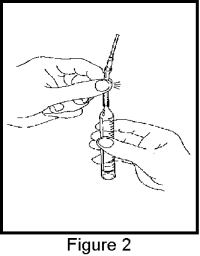
Note: When the tip is snapped, the flexible tubing will remain in place on the neck of the ampoule.
11. Lift the control bar and insert the Titret assembly into the Titrettor (fig 3).
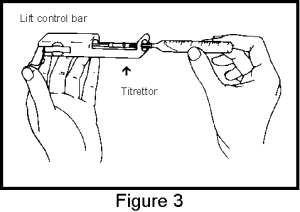
12. Hold the Titrettor with the sample pipe in the sample. Press the control bar firmly, but briefly, to pull in a small amount of sample. The contents will turn orange or pink (fig 4).
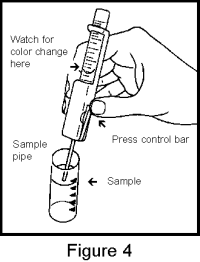
Note: NEVER press the control bar unless the sample pipe is in the sample.
13. Press the control bar again to draw another small amount of sample into the ampoule.
14. Rock the entire assembly to mix the contents of the ampoule. Watch for a color change FROM ORANGE TO BLUE.
Note: The endpoint color may appear in flashes, but the endpoint is reached only when the blue color is permanent (lasts for at least 30 seconds).
15. Repeat steps 13 and 14 until a permanent color change occurs.
16. When the color of the liquid in the ampoule changes to BLUE, this is the endpoint. Remove the ampoule from the Titrettor. Hold the ampoule flat end down, tapered tip up, and read the scale opposite the liquid level to obtain test results in ppm (mg/Liter) calcium carbonate (fig 5).
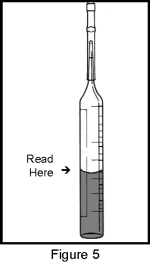
17. Rinse both syringes, sample cup, and beaker thoroughly with distilled water, then allow them to air dry.
Operating Tips:
The smaller the doses of sample that are added during testing, the more accurate the test result will be.
If the contents of the ampoule turn blue right away with the first small dose of sample in Step #12 (i.e. the contents never turn orange or pink), the result is greater than or equal to 350 ppm.
If the ampoule fills completely and the contents never turn blue (i.e. remain pink or orange), the test result is less than 50 ppm.
When the contents of the ampoule turn blue, the fuller the ampoule, the lower the test result. For example, if the Titret is approximately 3/4 full when the contents of the ampoule turn blue, then the test result is approximately 70 ppm.
See Interpretation of Results for a detailed explanation of the results.
Interpretation Of Results
In mares that have been evaluated by this test, there was a 54% probability that foaling would occur within 24 hours when the pre-foaling mammary secretion calcium first meets or exceeds 200 ppm. There was an 84% probability that foaling would occur within 48 hours when pre-foaling mammary secretion calcium first meets or exceeds 200 ppm, and a 98% probability that foaling would occur within 72 hours when prefoaling mammary secretion calcium first meets or exceeds 200 ppm. The majority of mares foal within a short period of time when a value of 300 to 500 ppm is obtained. But not all mares can be expected to reach these higher values. For mares that had not yet reached or exceeded 200 ppm, there was a 98% probability that foaling would not occur within the next 24 hour period.
Caution: This test does not claim to be 100% accurate in all mares. As with any biological system, exceptions are encountered, and no test can be expected to provide completely accurate and reliable results all of the time, in all situations. This is an aid to your foaling management program, and is not intended to guarantee a successful outcome in all mares.
Troubleshooting
When you first start testing your mare, it is not unusual for there to be no color change to blue during the test procedure, even when the ampoule is completely filled with liquid. This does not mean that the test is not working. It simply means that the test result is < 50 ppm (i.e., this mare is not even on scale yet). If you see only orange or pink (no blue), simply continue to test your mare daily. Her calcium content will increase and come on scale as she gets closer to the onset of labor.
It is not unusual for some mares to reach 100 to 175 ppm and remain at that level for several days at a time before proceeding up the scale to 200 ppm (or above). Variations occur between mares, and even within the same mare from year to year. Patience and careful monitoring on a once to twice daily schedule are a must. A dramatic rise, or significant change in value, over a 12- to 24-hour interval indicates that the mare is advancing towards her actual delivery.
Occasionally a value will drop from the previous day’s sampling; this is not cause for alarm. You may want to repeat the test procedure using care to follow the directions exactly.
Initial color of the diluted sample once the Indicator Solution has been added to it will vary from early in the mare’s testing period to later when she is closer to foaling. Early samples will appear more orange in color, later samples will appear a rose-pink to reddish purple. This is a normal variation we have observed and is not a cause for concern in accuracy of the result.
Interferences Or Complications
Mares that have been exposed to fescue grass pastures (specifically the Kentucky 31 variety) contaminated by the fungus Acremonium coephenophialum during the last 60-90 days of gestation may suffer from the toxins that are produced within the grass. Such mares very often fail to undergo normal udder development prior to foaling (and often even after), a problem referred to as agalactia. Without a sample for testing, this kit will be of little help to your management of such mares. Consult your veterinarian for prevention of this problem. In addition, the supplement domperidone which is given to mares to increase milk production can impact the calcium level of the mare’s milk, causing inflated readings with the Foal Watch test kit.
Obtaining the small sample volume that is required for testing on a once to twice daily basis, for 10 to 14 days prior to foaling, does not deprive the foal of any significant amount of colostrum (or its antibody content) once it is born and begins to nurse. Many foals have been monitored during the research and development of this procedure, and in no case was a failure of passive transfer (inadequate colostrum consumption and passing of antibodies from the mare’s milk to the foal) attributable to the sampling of pre-foaling mammary secretions. Also, the quality of the mare’s colostrum (its content of antibodies) is not affected. Mares that are prone to ‘running milk’ prior to foaling will do so whether they have been sampled for testing or not. Such mares are still at risk of losing too much colostrum prior to foaling and should be managed accordingly regardless of testing. Consult your veterinarian if you are not familiar with this problem.
The procedure of pre-foaling mammary secretion sampling slightly increases the risk of mastitis development (infection of the milk and mammary tissue or udder). This is true for any animal when milking is performed manually, especially if precautions are not taken to wipe the skin and teat surfaces clean, and dry them prior to obtaining the sample. If you note clumps of debris, or pink to red discoloration in the milk sample obtained from your mare, this may indicate an infection and you should consult your veterinarian for proper treatment.
REFERENCES
West T.S., DSC, Ph.D. Complexometry with EDTA and Related Reagents, 3rd ed. Poole, England: BDH Chemicals Ltd., p.46, 164 (1969).
W.B. Ley, J.L. Hoffman, et al. “Daytime Management of the Mare: 1: Pre-Foaling Mammary Secretions Testing.” Journal of Equine Veterinary Science, Vol. 9, No. 2, p.88-99, 1989.
Cat. No. K-1700
Visit www.foalingwatch.com to view product demonstration video.
Always follow the test procedure to perform a test.
CHEMetrics, Inc., Midland, VA 22728 USA
Phone: (800) 356-3072
Fax: (540) 788-4856
Web: www.foalingwatch.com
June 22, Rev. 14
Presentation: 20 individual tests per kit.
CPN: 1489000.2
By AquaPhoenix Scientific
4295 CATLETT RD., MIDLAND, VA, 22728
| Telephone: | 540-788-9026 | |
| Order Desk: | 800-356-3072 | |
| Technical Service: | 540-788-9026 | |
| Website: | www.foalingwatch.com |
 |
THIS SERVICE AND DATA ARE PROVIDED "AS IS". DVMetrics assumes no liability, and each user assumes full risk, responsibility, and liability, related to its use of the DVMetrics service and data. See the Terms of Use for further details. |

Copyright © 2024 Animalytix LLC. Updated: 2024-02-27
